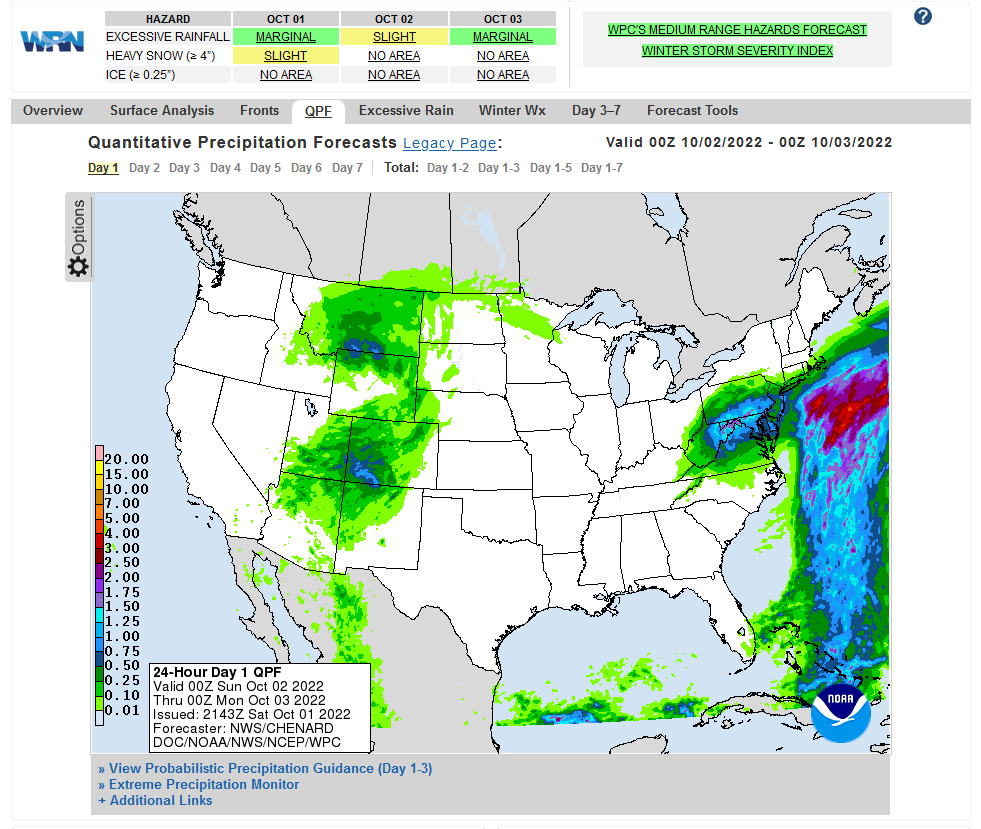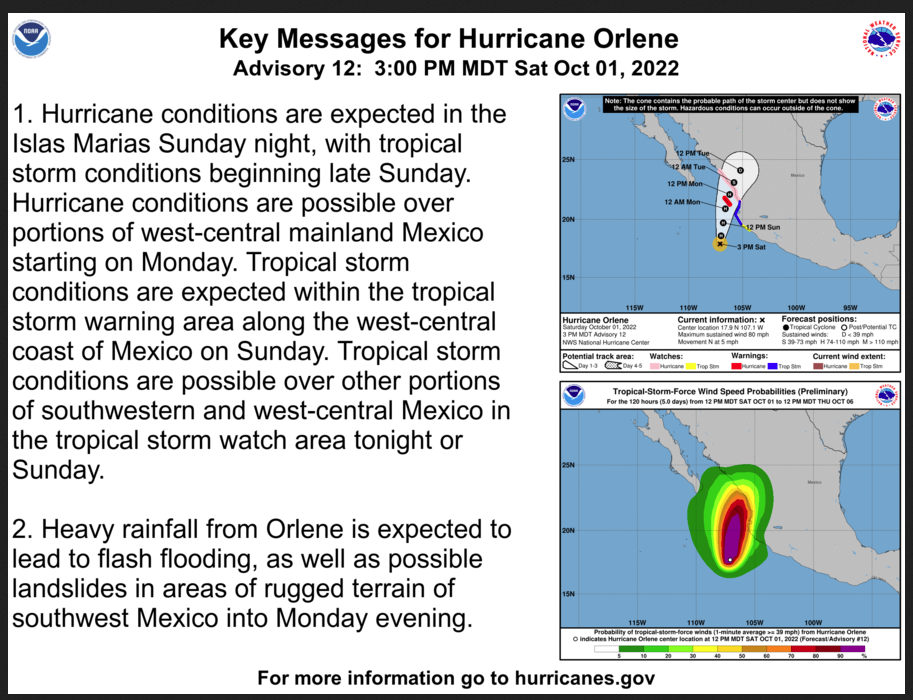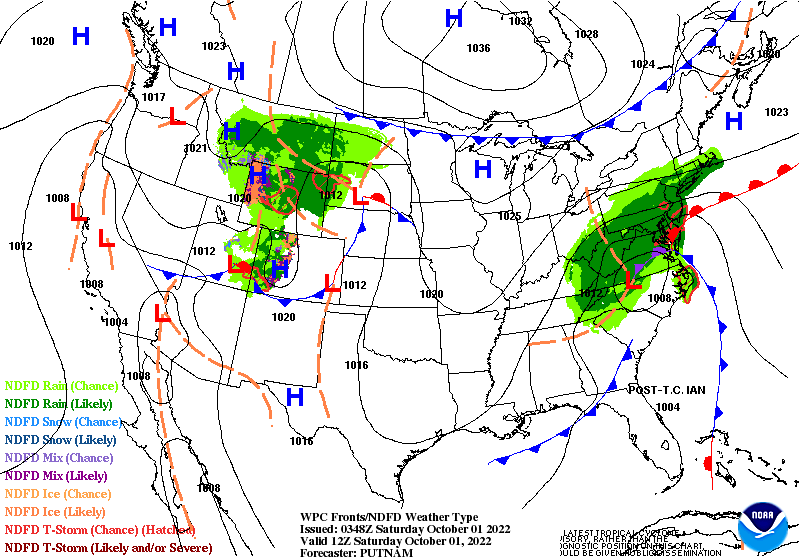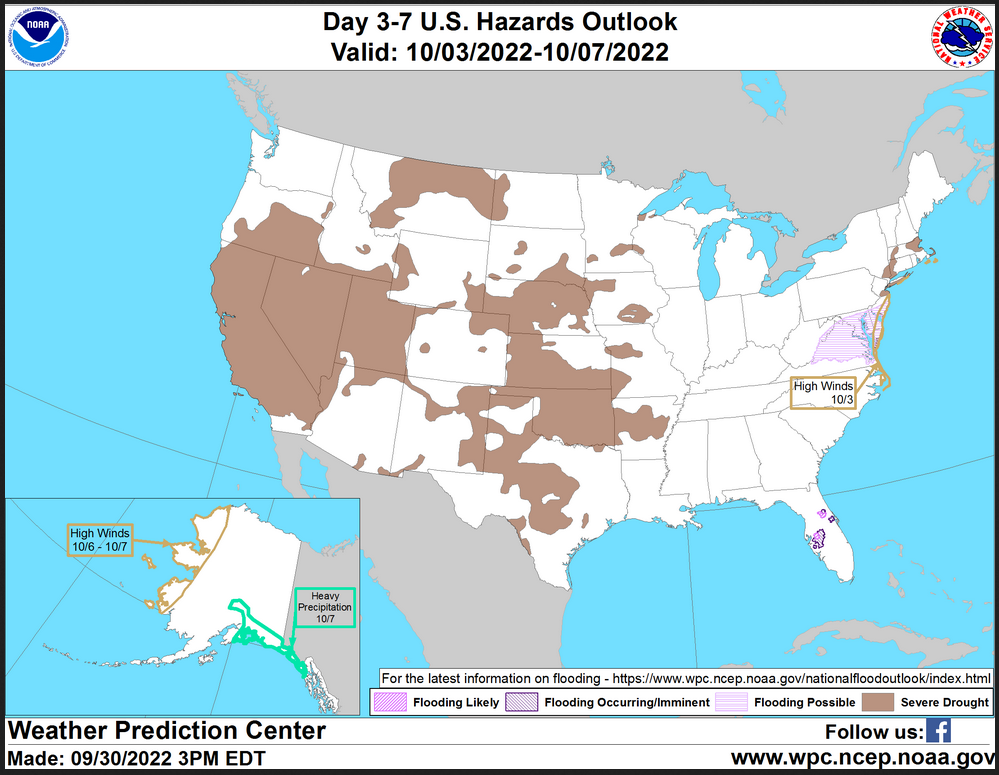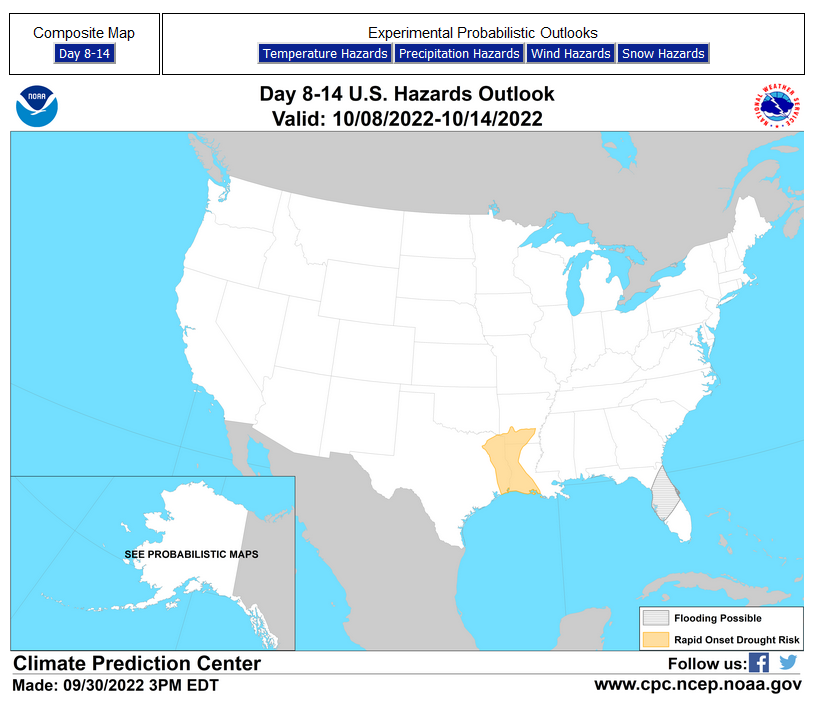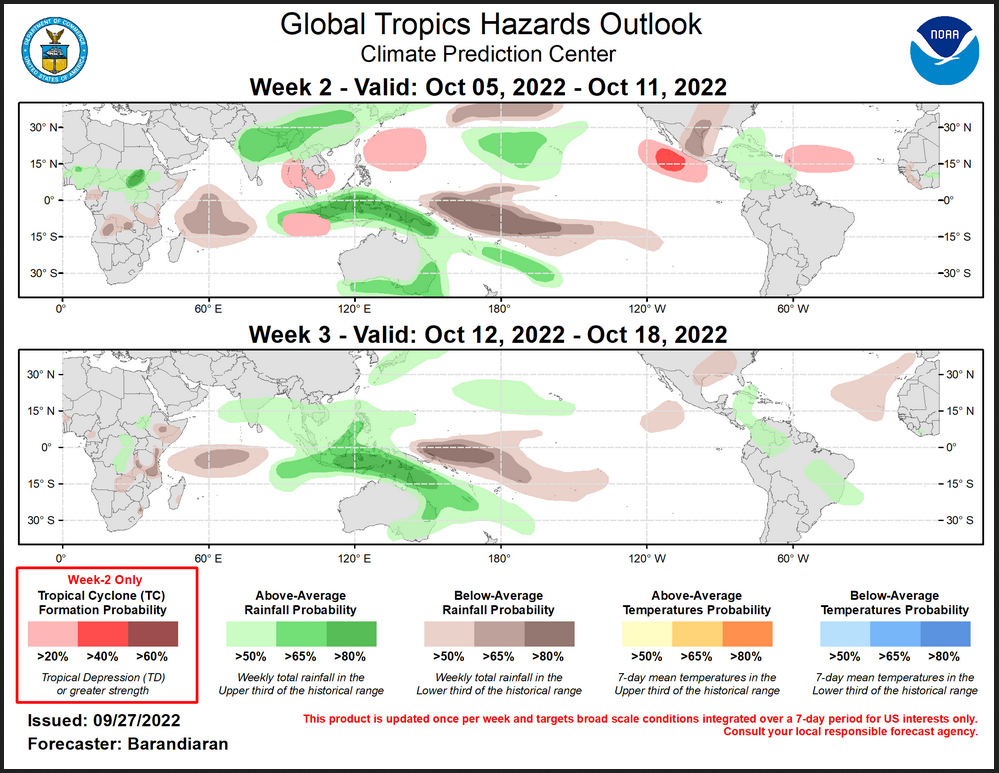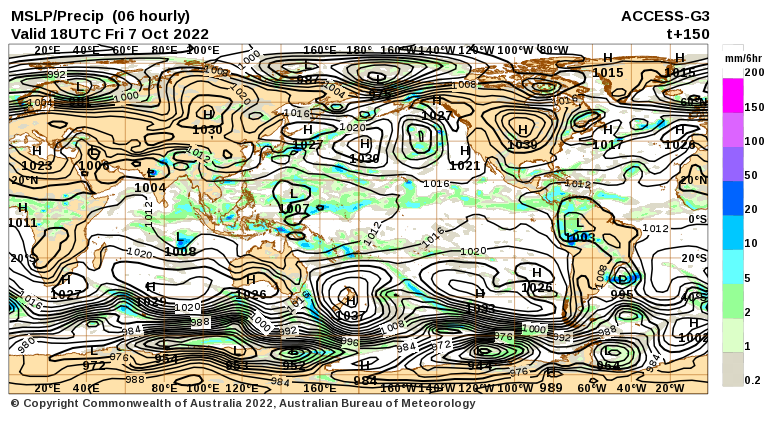Here is what we are paying attention to this evening and the next 48 hours from this afternoon’s NWS Forecast.
...There is a Slight Risk of excessive rainfall over parts of the Central Appalachians through Sunday morning... ...There is a Slight Risk of excessive rainfall over parts of the Great Basin and the Central Rockies from Sunday into Monday morning... ...Temperatures will be 10 to 15 degrees below average over parts of the Mid-Atlantic...
Continuation of the NWS Short Range Forecast (It is updated twice a day and these updates can be found here.
Post-Tropical Cyclone IAN will slowly dissipate near the North Carolina-Virginia border through Sunday evening. However, an upper-level low over the Mid-Atlantic will keep clouds and showers over the region through Monday. Moisture streaming inland off the Atlantic will produce heavy rain over parts of the Central Appalachians. Therefore, the WPC has issued a Slight Risk of excessive rainfall over parts of the Central Appalachians through Sunday morning. The associated heavy rain will create mainly localized areas of flash flooding, with urban areas, roads, and small streams the most vulnerable. The threat of excessive rainfall decreases slightly to a Marginal Risk over the Mid-Atlantic on Sunday and the threat moves to the immediate Mid-Atlantic Coast on Monday. The clouds and rain will keep temperatures 10 to 15 degrees below average on Sunday. Meanwhile, a second upper-level low over the Northern Rockies will slowly drift to the Northern High Plains by Monday evening. Moisture circulation around the Upper-low will aid in producing rain over the Northern Rockies and showers/thunderstorms over the Central Rockies into the Southwest. Therefore, the WPC has issued a Marginal Risk of excessive rainfall over parts of the Northern/Central Rockies and the Southwest through Sunday morning. The associated heavy rain will create localized areas of flash flooding, affecting areas that experience rapid runoff with heavy rain and burn scars the most vulnerable. Furthermore, on Sunday, the tropical moisture streaming over the Southwest into parts of the Great Basin will produce showers and thunderstorms with heavy rain over the area. Therefore, the WPC has issued a Slight Risk of excessive rainfall over parts of the Great Basin and Central Rockies from Sunday into Monday morning. The associated heavy rain will create mainly localized areas of flash flooding, with urban areas, roads, small streams, and burn scars the most vulnerable. On Monday, the threat of excessive rainfall decreases as the moisture flow is limited. However, there will still be showers and thunderstorms with the possibility of heavy rain over parts of the Southwest/Southern Rockies. Therefore, the WPC has issued a Marginal Risk of excessive rainfall over parts of the Southwest and Central/Southern Rockies on Monday morning. The associated heavy rain will create localized areas of flash flooding, affecting areas that experience rapid runoff with heavy rain and burn scars.
Current forecast of heavy precipitation
Maps that relate the forecast to geography can be found by clicking Here for Day 1 and Here for Day 2.
Here is a 60-hour animated forecast map that shows how the short-term forecast is expected to play out
If it needs to be updated click here.
HAZARDS OUTLOOKS
Click here for the latest complete Day 3 -7 Hazards forecast which updates only on weekdays. Once a week probably Monday or Tuesday I will update the images. I provided the link for readers to get daily updates on weekdays. Use your own judgment to decide if you need to update these images.
Worldwide Tropical Forecast
(This graphic updates on Tuesdays) If it has not been updated, you can get the update by clicking here This is a new approach and covers weeks 2 and 3 not weeks 1 and 2. It has more information but I am having trouble getting used to it. As usual, it comes with a discussion which is below
Outlook Discussion Last Updated – 09/27/22
Valid – 10/05/22 – 10/18/22
Madden-Julian Oscillation (MJO) activity is increasing after a recent period of incoherent tropical convective activity. Tropical convection is coalescing into a wave 1-like pattern with enhanced(suppressed) convection over the Maritime Continent(Eastern Pacific) and modest eastward propagation of these features, especially the suppressed phase. Looking ahead, there is widespread agreement among dynamical model RMM-based forecasts for the high probability of an upcoming significant MJO event. The general consensus is that the RMM signal will emerge from the unit circle during the week-1 timeframe in phase 4 or 5 and amplify significantly while propagating slowly eastward during weeks 2-3. Tropical cyclone (TC) activity has been high over the last week. A pair of TCs formed south of Japan (Noru, 9/22; Kulap, 9/25). Noru became a strong typhoon and is currently moving toward the Vietnam coast, while Kulap has stayed out to sea and is set to become an extratropical system in the coming days. TC Newton formed in the East Pacific on 9/21 and dissipated quickly without affecting land. TC Ashley formed in the southern Indian Ocean 9/26 but is not expected to have any impacts to land. In the Atlantic Basin, TC Hermine formed near the Cape Verde Islands on 9/23 and quickly dissipated. Later on 9/23, TC Ian formed in the Caribbean Sea, and is currently near Cuba as an intensifying hurricane. Ian is anticipated to come ashore along the eastern Gulf Coast in the coming days with the potential for heavy rain and high winds during the next few days. Please refer to the National Hurricane Center (NHC) for more information and the latest forecasts.
Looking ahead to week 2, heightened MJO activity and the La Niña base state when coupled with a westerly wind burst over the equatorial Indian Ocean depicted in multiple dynamical models provide favorable conditions for TC formation on either side of the equator for the Eastern Indian Ocean. Model guidance from the ECMWF and GEFS also indicate heightened probabilities of TC formation during the week-2 time period covering a broad area in Philippine Sea, the Eastern Pacific Basin and the Main Development Region (MDR) of the Atlantic Basin.
The precipitation outlook for the next two weeks is based on anticipated TC tracks, ongoing La Nina conditions, and consensus of GEFS, CFS, and ECMWF ensemble mean solutions. Suppressed (enhanced) rainfall continues near and to the west of the Date Line (over the Maritime Continent) due to ongoing La Nina conditions and anticipated MJO phase. Below-normal precipitation is anticipated for the western tropical Indian Ocean for both weeks 2 and 3.
For hazardous weather conditions in your area during the coming two-week period, please refer to your local NWS office, the Medium Range Hazards Forecast produced by the Weather Prediction Center, and the CPC Week-2 Hazards Outlook. Forecasts made over Africa are made in coordination with the International Desk at CPC.
Detailed Maps and Reports for the Western Atlantic and the Pacific Oceans
Below are three maps that summarize the situation for the Atlantic, Eastern and Central Pacific. Additional information can be accessed by clicking H ERE
First the Atlantic
Click to view the forecast map and have access to additional information https://www.nhc .noaa.gov/gtwo.php?basin= atlc&fdays=5
Then Eastern Pacific
Click to view the forecast map and have access to additional information https://www.nhc.noaa.gov/gtwo.php?basin=epac&fdays=5
Then Central Pacific
Click to view the forecast map and have access to additional information https://www.nhc.noaa.gov/gtwo.php?basin=cpac&fdays=5
And the Western Pacific
Click to view the forecast map and have access to additional information https://www.metoc.navy.mil/jtwc/jtwc.html
Some Intermediate-Term Outlooks
Links to “Outlook” maps and discussions for three time periods. Days 6 – 10, Days 8 – 14, and Weeks 3 and 4. An outlook differs from a forecast based on how NOAA uses these terms in that an “outlook” presents information from deviation from normal and the likelihood of these deviations.
You have to click on the links because they do not update automatically and I do not want to have stale images in the article. But it is not difficult to click on a link and you get a large image plus a discussion. On Fridays in a separate article, we will show the images and provide a link in this article that article. But remember what you will see is the images as of Friday. But here you can get the current images simply by clicking on them. Then hit the return arrow at the upper left of your screen to return to the article. You will not find this information easily anywhere else.
Right now you can find these maps here (We show them every Friday there but you can click above and find them).
World Forecast for Day 6 (Currently Set for Day 6 but the reader can change that)
World Weather Forecast produced by the Australian Bureau of Meteorology. Unfortunately, I do not know how to extract the control panel and embed it into my report so that you could use the tool within my report. But if you visit it Cl ick Here and you will be able to use the tool to view temperature or many other things for THE WORLD. It can forecast out for a week. Pretty cool. Return to this report by using the “Back Arrow” usually found top left corner of your screen to the left of the URL Box. It may require hitting it a few times depending on how deep you are into the BOM tool. Below are the current worldwide precipitation and air pressure forecasts for six days out. They will not auto-update and right now are current for Day 6. If you want the forecast for a different day Click Here I will try to update this map each day but you have the link so you can access the dashboard and get a wide variety of forecasts.I mostly rely on the reader to interpret world maps. For this map, areas of expected precipitation for the date and time shown are clearly shown. The number of High-Pressure systems shown is called the Wave Number. Maybe I will discuss WN someday. But it shows how many Rossby Waves there are around the World. Sometimes they are hard to count. Counting Low-Pressure systems should provide the same WN. Rossby Waves are the way the temperature distribution of the Planet remains in balance. It is basically the science of fluid dynamics. It can be very helpful in predicting the movement of weather patterns. You can snip an area of interest and move it into MS Paint and enlarge it.
Month to Date Information
Month to date Temperature can be found at https://hprcc.unl.edu/products/maps/acis/MonthTDeptUS.png
Month to date Precipitation can be found at https://hprcc.unl.edu/products/maps/acis/MonthPNormUS.png

